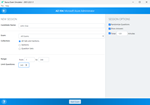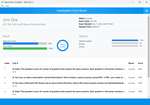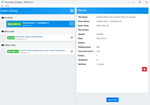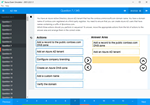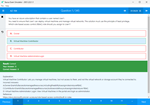Download Microsoft Dynamics 365 Business Central Developer (beta).MB-820.VCEDumps.2024-04-11.33q.tqb
| Vendor: | Microsoft |
| Exam Code: | MB-820 |
| Exam Name: | Microsoft Dynamics 365 Business Central Developer (beta) |
| Date: | Apr 11, 2024 |
| File Size: | 3 MB |
How to open TQB files?
Files with TQB (Taurus Question Bank) extension can be opened by Taurus Exam Studio.
Purchase
Coupon: TAURUSSIM_20OFF
Discount: 20%
Demo Questions
Question 1
A company plans to deploy Business Central.
The company has the following deployment requirements:
- Use the company hardware architecture to run the deployment.
- Use sandbox environments to develop extensions.
- Allow tenants to connect to Shopify with the standard connector.
- Use Microsoft Power Automate to create a workflow that calls a business event.
You need to identify the deployment type for each requirement.
Which deployment types should you use? To answer, move the appropriate deployment types to the correct requirements. You may use each deployment type once, more than once, or not at all.
Correct answer: To work with this question, an Exam Simulator is required.
Question 2
A company is examining Connect apps and Add-on apps for use with Business Central.
You need to describe the development language requirements for Connect apps and Add-on apps.
How should you describe the app language requirements? To answer, move the appropriate app types to the correct descriptions. You may use each app type once, more than once, or not at all. You may need to move the split bar between panes or scroll to view content.
NOTE: Each correct selection is worth one point.
Correct answer: To work with this question, an Exam Simulator is required.
Question 3
A company is implementing Business Central.
In the per-tenant extension, TableA Header and TableA Line are document tables, and TableB Header and TableB Line are document history tables.
The company requires that the resulting dataset of query objects contain the following records:
- All records from TableA Header even if no matching record value exists in the linked TableA Line
- Records from TableB Header where a match is found in the linked TableB Line field
You need to configure the linked data item to generate the required dataset.
Which SqlJoinType should you use? To answer, move the appropriate SqUoinTypes to the correct dataset requirements. You may use each SqlJoinType once, more than once, or not at all. You may need to move the split bar between panes or scroll to view content.
Correct answer: To work with this question, an Exam Simulator is required.
Question 4
A company has a page named New Job Status connected to a source table named Job. The page has an action named Item Ledger Entries. The company requires the following changes to the page:
- Filter the page to display only jobs with open or quote status.
- Add the following comment for internal use: This page does not include completed jobs.
- Item Ledger Entries action must open the selected job on the page and display it in the Ul for users to modify.
You need to select the property selections to use for each requirement.
Which property selections should you use? To answer, select the appropriate options in the answer area.
NOTE: Each correct selection is worth one point.
Correct answer: To work with this question, an Exam Simulator is required.
Question 5
A company plans to meet new regulatory requirements.
The regulator has issued new tax tiers.
You need to update the base application table by using a table extension.
Which table field property can you change?
- CalcFormula
- DecimalPlaces
- BlankZero
- AutoFormatType
Correct answer: B
Explanation:
When updating the base application table using a table extension in Microsoft Dynamics 365 Business Central, certain properties of table fields can be modified to meet new requirements, such as regulatory changes. TheDecimalPlaces property (B) is one such property that can be adjusted in a table extension. This property determines the number of decimal places that are displayed and stored for decimal fields in the table. Adjusting theDecimalPlaces property can be particularly useful when dealing with financial data and tax calculations that require precision to meet new tax tiers set by a regulator. It's important to note that not all properties can bemodified in a table extension; for example, the CalcFormula property (A) cannot be changed as it affects how the field's value is calculated, which could have significant implications on the base application's logic. When updating the base application table using a table extension in Microsoft Dynamics 365 Business Central, certain properties of table fields can be modified to meet new requirements, such as regulatory changes. The
DecimalPlaces property (B) is one such property that can be adjusted in a table extension. This property determines the number of decimal places that are displayed and stored for decimal fields in the table. Adjusting the
DecimalPlaces property can be particularly useful when dealing with financial data and tax calculations that require precision to meet new tax tiers set by a regulator. It's important to note that not all properties can be
modified in a table extension; for example, the CalcFormula property (A) cannot be changed as it affects how the field's value is calculated, which could have significant implications on the base application's logic.
Question 6
You have the following XML file sample for the Items list:

You plan to create the next XML file by using an XMLport object.
You need to complete the code segment to export the file in the required format
How should you complete the code segment? To answer, select the appropriate options in the answer area.
Correct answer: To work with this question, an Exam Simulator is required.
Question 7
You need to write the code to call the subcontractor's REST API.
How should you complete the code segment? To answer, select the appropriate options in the answer area.
NOTE: Each correct selection is worth one point.
Correct answer: To work with this question, an Exam Simulator is required.
Question 8
You are developing an app that will be published to Microsoft AppSource.
The app requires code analyzers to enforce some rules. You plan to add the analyzers to the settings.json file.
You need to activate the analyzers for the project.
Which three code analyzers should you activate to develop the app for AppSource? Each correct answer presents part of the solution
NOTE: Each correct selection is worth one point.
- CodeCop
- UlCop
- a custom rule set
- PerTenantExtensionCop
- AppSourceCop
Correct answer: ADE
Explanation:
When developing an app for Microsoft AppSource, it is crucial to adhere to specific guidelines and standards to ensure compatibility and compliance. The three code analyzers you should activate are:CodeCop (A): This is the default analyzer for AL language extensions. It enforces the AL Coding Guidelines, ensuring that the code follows best practices for readability, maintainability, and performance. It checks for a widerange of issues, from syntax errors to best practice violations, making it essential for any AL development.PerTenantExtensionCop (D): This analyzer is specifically designed for extensions that are intended to be installed for individual tenants. It includes rules that ensure the extension does not interfere with the per-tenantcustomizations and adheres to the guidelines for extensions that can be safely installed and uninstalled without affecting the underlying application.AppSourceCop (E): This analyzer is tailored for extensions that are intended for publication on Microsoft AppSource. It enforces additional rules that are specific to AppSource submissions, such as checking for the use ofreserved object ranges and ensuring that all prerequisite dependencies are correctly declared. This is crucial for ensuring that your app meets all the requirements for listing on AppSource.By activating these three analyzers, developers can ensure their app adheres to the standards required for AppSource, as well as maintain high code quality and compatibility with Business Central. When developing an app for Microsoft AppSource, it is crucial to adhere to specific guidelines and standards to ensure compatibility and compliance. The three code analyzers you should activate are:
CodeCop (A): This is the default analyzer for AL language extensions. It enforces the AL Coding Guidelines, ensuring that the code follows best practices for readability, maintainability, and performance. It checks for a wide
range of issues, from syntax errors to best practice violations, making it essential for any AL development.
PerTenantExtensionCop (D): This analyzer is specifically designed for extensions that are intended to be installed for individual tenants. It includes rules that ensure the extension does not interfere with the per-tenant
customizations and adheres to the guidelines for extensions that can be safely installed and uninstalled without affecting the underlying application.
AppSourceCop (E): This analyzer is tailored for extensions that are intended for publication on Microsoft AppSource. It enforces additional rules that are specific to AppSource submissions, such as checking for the use of
reserved object ranges and ensuring that all prerequisite dependencies are correctly declared. This is crucial for ensuring that your app meets all the requirements for listing on AppSource.
By activating these three analyzers, developers can ensure their app adheres to the standards required for AppSource, as well as maintain high code quality and compatibility with Business Central.
Question 9
You are developing an app.
You plan to publish the app to Microsoft AppSource.
You need to assign an object range for the app.
Which object range should you use?
- custom object within the range 50000 to 59999
- custom object within the range 50000 to 99999
- divided by countries and use specific a country within the range 100000 to 999999
- an object range within the range of 7000000 to 74999999 that is requested from Microsoft
- free object within the standard range 1 to 49999
Correct answer: D
Explanation:
When developing an app for Microsoft AppSource, it is essential to use an object range that is specifically designated by Microsoft to avoid conflicts with other apps and the base application. The correct object range to use is:An object range within the range of 70000000 to 74999999 that is requested from Microsoft (D): This range is reserved for AppSource apps. Developers need to request this range from Microsoft to ensure that the objectsused in their extension do not conflict with those used by other extensions or by the base application. Using this reserved range helps maintain the integrity and compatibility of extensions published on AppSource.It's important to note that the other ranges mentioned (A, B, C, and E) are not suitable for apps intended for AppSource. Ranges 50000 to 59999 and 50000 to 99999 are typically reserved for per-tenant customizations orpartner solutions, not for distribution on AppSource. The standard range 1 to 49999 is reserved for the base application objects, and using an object range divided by countries (C) is not a standard practice for AppSourceapps. When developing an app for Microsoft AppSource, it is essential to use an object range that is specifically designated by Microsoft to avoid conflicts with other apps and the base application. The correct object range to use is:
An object range within the range of 70000000 to 74999999 that is requested from Microsoft (D): This range is reserved for AppSource apps. Developers need to request this range from Microsoft to ensure that the objects
used in their extension do not conflict with those used by other extensions or by the base application. Using this reserved range helps maintain the integrity and compatibility of extensions published on AppSource.
It's important to note that the other ranges mentioned (A, B, C, and E) are not suitable for apps intended for AppSource. Ranges 50000 to 59999 and 50000 to 99999 are typically reserved for per-tenant customizations or
partner solutions, not for distribution on AppSource. The standard range 1 to 49999 is reserved for the base application objects, and using an object range divided by countries (C) is not a standard practice for AppSource
apps.
Question 10
A company is deploying Business Central on-premises.
The company plans to use a single-tenant deployment architecture.
You need to describe how the data is stored and how the Business Central Server is configured.
In which two ways should you describe the single-tenant architecture? Each correct answer presents a complete solution.
NOTE: Each correct selection is worth one point.
- Each customer has their own Business Central Server.
- The application and the business data are stored in the same database.
- Multiple customers share a single Business Central Server.
- The application and business data are stored in separate databases.
- Multiple customers share multiple Business Central Server instances.
Correct answer: BD
Explanation:
In a single-tenant deployment architecture of Business Central on-premises, the following characteristics describe how the data is stored and how the Business Central Server is configured:The application and the business data are stored in the same database (B): In a single-tenant architecture, each tenant (which typically corresponds to a single customer) has its own dedicated database. This databasecontains both the application objects (such as pages, reports, codeunits, etc.) and the business data (such as customer, vendor, and transaction records). This setup ensures that each tenant's data is isolated and can bemanaged independently.The application and business data are stored in separate databases (D): While (B) is a characteristic of a single-tenant deployment, it's important to clarify that in some configurations, the application objects can be stored in aseparate database from the business data. This approach can be used for easier maintenance and upgrades of the application code without affecting the business data. However, each tenant still has its own set of databases,maintaining the single-tenancy model.The other options provided do not accurately describe a single-tenant architecture:Each customer has their own Business Central Server (A): This statement might be misleading. In a single-tenant deployment, while each customer has their own database, they do not necessarily have their own BusinessCentral Server instance. Multiple databases (tenants) can be hosted on a single server instance, although they are not shared across customers.Multiple customers share a single Business Central Server (C) and Multiple customers share multiple Business Central Server instances (E): These options describe a multi-tenant architecture rather than a single-tenant one. Ina multi-tenant setup, multiple customers (tenants) can share the same server instance and even the same application database, with data isolation ensured at the application level. In a single-tenant deployment architecture of Business Central on-premises, the following characteristics describe how the data is stored and how the Business Central Server is configured:
The application and the business data are stored in the same database (B): In a single-tenant architecture, each tenant (which typically corresponds to a single customer) has its own dedicated database. This database
contains both the application objects (such as pages, reports, codeunits, etc.) and the business data (such as customer, vendor, and transaction records). This setup ensures that each tenant's data is isolated and can be
managed independently.
The application and business data are stored in separate databases (D): While (B) is a characteristic of a single-tenant deployment, it's important to clarify that in some configurations, the application objects can be stored in a
separate database from the business data. This approach can be used for easier maintenance and upgrades of the application code without affecting the business data. However, each tenant still has its own set of databases,
maintaining the single-tenancy model.
The other options provided do not accurately describe a single-tenant architecture:
Each customer has their own Business Central Server (A): This statement might be misleading. In a single-tenant deployment, while each customer has their own database, they do not necessarily have their own Business
Central Server instance. Multiple databases (tenants) can be hosted on a single server instance, although they are not shared across customers.
Multiple customers share a single Business Central Server (C) and Multiple customers share multiple Business Central Server instances (E): These options describe a multi-tenant architecture rather than a single-tenant one. In
a multi-tenant setup, multiple customers (tenants) can share the same server instance and even the same application database, with data isolation ensured at the application level.
HOW TO OPEN VCE FILES
Use VCE Exam Simulator to open VCE files

HOW TO OPEN VCEX FILES
Use ProfExam Simulator to open VCEX files


ProfExam at a 20% markdown
You have the opportunity to purchase ProfExam at a 20% reduced price
Get Now!